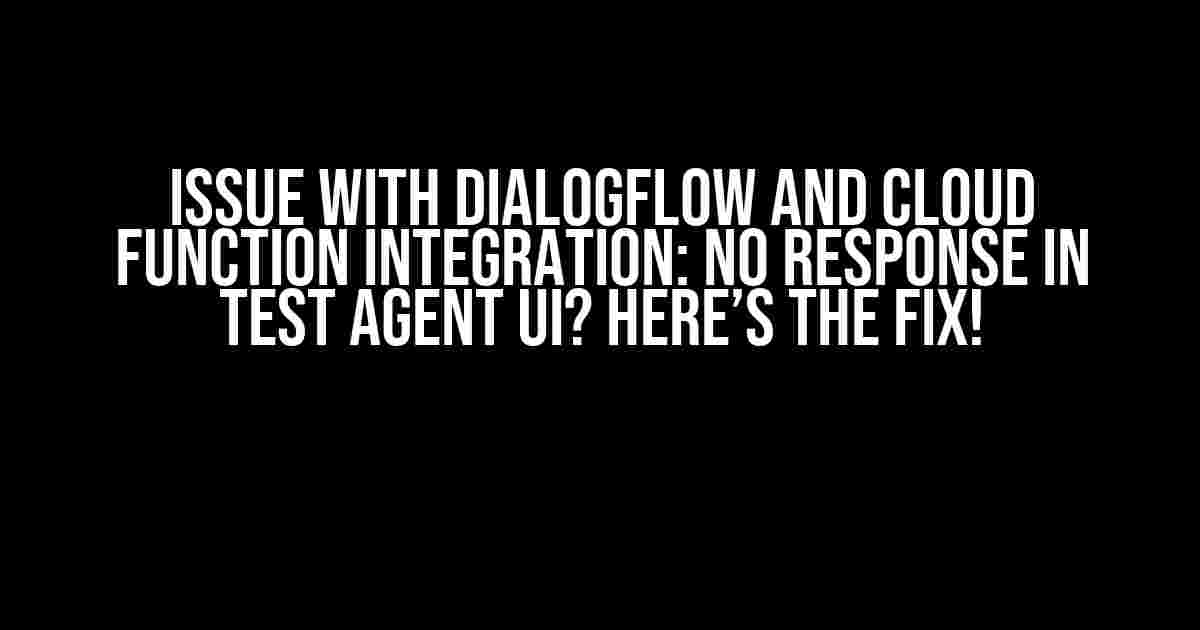If you’re reading this, chances are you’re stuck in a frustrating loop of “no response” errors while trying to integrate Dialogflow with Cloud Functions. Don’t worry, friend, you’re not alone! Many developers have faced this issue, and today, we’re going to tackle it head-on.
What’s Going On?
When you integrate Dialogflow with Cloud Functions, you expect a seamless conversation flow. However, sometimes, the Test Agent UI fails to respond, leaving you wondering what went wrong. There are several reasons why this might happen, and we’ll explore them together.
Reason 1: Incorrect Cloud Function Setup
The most common mistake is misconfiguring the Cloud Function. Make sure you’ve followed these steps:
cloud functions:deployis executed with the correct project ID and function name.- The function is deployed to the correct region (e.g.,
us-central1). - The function has the correct runtime (e.g.,
Node.js 14).
gcloud functions deploy myFunction --runtime nodejs14 --region us-central1 --trigger-http --allow-unauthenticatedReason 2: Inadequate Permissions
Dialogueflow and Cloud Functions require specific permissions to communicate with each other. Ensure that:
- The service account used by Cloud Functions has the
Dialogflow Agentrole. - The service account has permission to access the Dialogflow project.
gcloud projects add-iam-policy-binding [PROJECT_ID] --member serviceAccount:[SERVICE_ACCOUNT_EMAIL] --role roles/dialogflow.agentReason 3: Incorrect Webhook Configuration
The webhook configuration in Dialogflow might be the culprit. Check that:
- The webhook is enabled and configured correctly in Dialogflow.
- The Cloud Function URL is correctly set as the webhook URL.
https://[REGION]-[PROJECT_ID].cloudfunctions.net/[FUNCTION_NAME]Finding the Root Cause
To identify the issue, follow these steps:
-
Check the Cloud Function logs to see if the function is being triggered.
-
Verify that the Dialogflow request is being sent to the Cloud Function.
-
Use the Dialogflow simulator to test the agent and observe the response.
gcloud functions logs read --region [REGION] --project [PROJECT_ID] --function [FUNCTION_NAME]Solution: A Step-by-Step Guide
Now that we’ve identified the common issues, let’s walk through a step-by-step solution:
Step 1: Create a New Cloud Function
Create a new Cloud Function using the following code:
exports.dialogflowFirebaseFulfillment = functions.https.onCall((data, context) => {
const { queryResult } = data;
const { fulfillmentText } = queryResult;
return { fulfillmentText: fulfillmentText };
});Step 2: Deploy the Cloud Function
Deploy the Cloud Function using the command:
gcloud functions deploy dialogflowFirebaseFulfillment --runtime nodejs14 --region us-central1 --trigger-http --allow-unauthenticatedStep 3: Configure Webhook in Dialogflow
In Dialogflow, navigate to the Integrations tab and click on “Webhooks”.”
| Webhook Name | Enabled | URL |
|---|---|---|
| Cloud Function Webhook | true | https://[REGION]-[PROJECT_ID].cloudfunctions.net/dialogflowFirebaseFulfillment |
Step 4: Test the Integration
In the Dialogflow simulator, test the agent with a sample input:
Hi, I'd like to know the weatherThe response should now be displayed in the simulator.
Conclusion
Frustrating errors can be a thing of the past! By following these steps and double-checking your configuration, you should be able to resolve the “no response” issue with Dialogflow and Cloud Function integration. Remember to:
- Verify Cloud Function setup and permissions.
- Ensure correct webhook configuration.
- Test the integration using the Dialogflow simulator.
If you’re still stuck, feel free to ask for help in the comments below. Happy integrating!
Frequently Asked Question
Stuck with Dialogflow and Cloud Function integration? Get answers to your most pressing questions about resolving the “No Response” issue in the Test Agent UI!
Why am I not getting a response from my Cloud Function in the Dialogflow Test Agent UI?
This issue often occurs when there’s a misconfiguration in your Cloud Function or Dialogflow setup. Double-check that your Cloud Function is properly deployed, and its URL is correctly configured in your Dialogflow fulfillment settings. Also, ensure that the dependencies and permissions are in place, and the function is executable.
How can I troubleshoot the “No Response” issue in the Test Agent UI?
To troubleshoot this issue, start by checking the Cloud Function logs for any errors or exceptions. You can also test your Cloud Function by invoking it directly using the Cloud Console or the `gcloud` command-line tool. Additionally, verify that your Dialogflow agent is correctly configured to call the Cloud Function, and the intent is properly set up to trigger the function.
What are some common mistakes to avoid when integrating Dialogflow with Cloud Functions?
Some common mistakes to avoid include incorrect Cloud Function URL configuration, mismatched intent names, and incorrectly set up fulfillment settings in Dialogflow. Additionally, ensure that the Cloud Function is properly deployed to the correct region and that the dependencies are up-to-date.
How do I test my Cloud Function to ensure it’s working correctly?
You can test your Cloud Function by invoking it directly using the Cloud Console or the `gcloud` command-line tool. You can also use tools like Postman or cURL to send a request to the Cloud Function URL. Verify that the function returns the expected response, and check the Cloud Function logs for any errors or exceptions.
What are some best practices to keep in mind when integrating Dialogflow with Cloud Functions?
Some best practices include keeping your Cloud Function code organized and maintainable, using environment variables to store sensitive information, and implementing error handling and logging mechanisms. Additionally, ensure that your Cloud Function is designed to handle concurrent requests and is scalable to meet your application’s needs.

